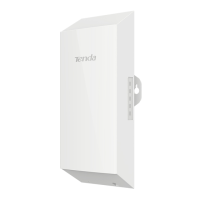77
Parameters Description
It specifies whether to enable the VLAN function of this device. By default, it is disabled. After the
VLAN function is enabled, the PoE LAN/WAN port is used as trunk port.
It specifies the ID of the default native VLAN of the trunk port. The default ID is 1. After the VLAN
function is enabled, the PoE LAN/WAN port is used as trunk port.
It specifies the ID of the management VLAN of this device. The default ID is 1. After changing the
management VLAN, you can manage this device only after connecting your computer to the new
management VLAN.
It allows you to set a VLAN ID for the wireless network of this device. By default, it is set to 1000.
After the VLAN function is enabled, the WLAN interface functions as an access port, whose PVID is
the same as VLAN ID.
It allows you to set a VLAN ID for the LAN port (wired network) of this device. By default, it is set to
1.
After the VLAN function is enabled, the WLAN interface functions as an access port, whose PVID is
the same as VLAN ID.
After the IEEE 802.1Q VLAN settings take effect, packet with tag will be forwards to the ports of the
corresponding VLAN according to the VID of the packet, and packet without tag will be forwards to the ports of
the corresponding VLAN according to the PVID of the port.
The following form shows the details about how different link type ports address received packets:
Forward the data to the
ports of the corresponding
VLAN based on the VID in
the tag.
Forward the data to the
ports of the corresponding
VLAN based on the PVID of
ports
Strip the tag in the packet and then forward it
VID = PVID of the port, strip the tag in the
packet and then forward it
VID ≠ PVID of the port, retain the tag in the
packet and then forward it
6.5.3 Examples of Configuring VLAN Settings
Networking Requirement
The CPEs connected to the same switch should belong to different VLANs.
Assumption:
CPE1 belongs to VLAN10, and CPE2 belongs to VLAN20.

